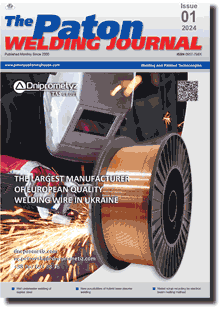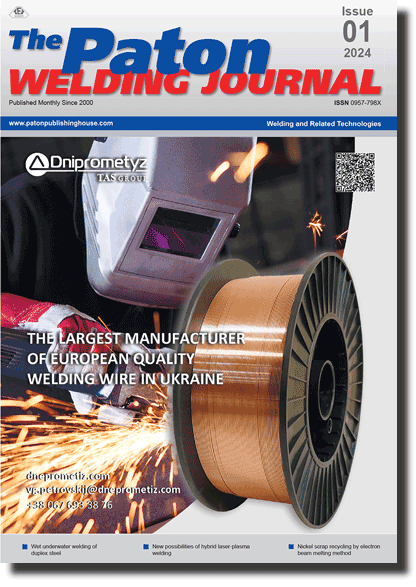| 2024 №01 (02) |
DOI of Article 10.37434/tpwj2024.01.03 |
2024 №01 (04) |

The Paton Welding Journal, 2024, #1, 22-26 pages
Impact of heat treatment on mechanical properties of joints during electron beam welding of 2219 alloy
V.V. Skryabinsky, V.M. Nesterenkov, M.O. Rusynyk
E.O. Paton Electric Welding Institute of the NASU. 11 Kazymyr Malevych Str., 03150, Kyiv, Ukraine. E-mail: skriabinski.vv.555@gmail.comAbstract
The plates of 2219 alloy of 40 mm thickness were welded by electron beam welding. The eff ect of sequence of welding operations and heat treatment on the mechanical properties of joints and distribution of hardness in the heat-aff ected-zone (HAZ) were studied. It was established that the plates of 2219 alloy, that were hardened before welding and artifi cially aged after welding, have highest strength. The aging improves the ultimate strength of the joints from 300…315 to 385...395 MPa, and the hardness of the weld and HAZ metal increases by 5…10 HRB units. In the study of joints microstructure, it was found that at a distance of about 1.0 mm from the fusion line in HAZ, a region of high-temperature return to the hardened state is located. It is characterized by an increase in hardness after aging to the level of hardness of the base metal. Measuring thermal welding cycles, it was found that the maximum heating temperature of this region is about 590 °C. Next, an annealing region is located. In this region, a decrease in the hardness of metal by 2...3 units HRB is observed. For welding speed of 20 mm/s, the width of HAZ is about 8 mm and artifi cial aging, carried out after welding, reduces it to 6 mm. Ref. 8, Tabl. 3, Fig. 6.
Keywords: electron beam welding, aluminium alloy, welded joints, heat treatment, mechanical properties, ultimate strength
Received: 12.10.2023
Received in revised form: 15.12.2023
Accepted: 17.01.2024
References
1. D.K. Zhang, G.Q. Wang, A.P. Wu, Y. Zhao, Q. Li, X.L. Liu, et al. (2019) Study on the inconsistency in mechanical properties of 2219 aluminium alloy TIG-welded joints. J. of Alloys and Compounds, 777, 10, 1044-1053. https://doi.org/10.1016/j.jallcom.2018.10.1822. Tianyi Zhao, Yue Zhao, Zhandong Wan, Pengcheng Shang, Aiping Wu, Quan Li, Dongyang Yan (2023). «Anneal» softening effect of 2219-T8 aluminum alloy joint during welding and its influence on prediction of welding residual stresses. J. Materials Research Technology, 24, 5202-5214. https://doi.org/10.1016/j.jmrt.2023.04.093
3. Deng-Kui Zhang, Guo-Qing Wang, Ai-Ping Wu, Ji-Guo Shan, Yue Zhao, Tian-Yi Zhao, Dan-Yang Meng, Jian-Ling Song, Zhong-Ping Zhang. (2019) Effects of Post-weld Heat Treatment on Microstructure, Mechanical Properties and the Role of Weld Reinforcement in 2219 Aluminum Alloy TIG-Welded joints. https://doi.org/10.1007/s40195-018-00869-w
4. Y. C. Chen, H. J. Liu, J. C. Feng. (2005) Effect of post-weld heat treatment on the mechanical properties of 2219-O friction stir welded joints. J. of Materials Science, 41 (1), 297-299. https://doi.org/10.1007/s10853-005-4085-y
5. S. Malarvizhi, K. Raghukandan & N. Viswanathan (2008) Effect of post weld aging treatment on tensile properties of electron beam welded AA2219 aluminum alloy. The International. J. of Advanced Manufacturing Technology, 37, 294-301. https://doi.org/10.1007/s00170-007-0970-7
6. Rabkin, D.M., Lozovskaya, A.V., Sklabinskaya, I.E. (1992) Metals science of aluminium and its alloys. Kyiv, Naukova Dumka.
7. Lozovskaya, A. V., Chaika, A. A., Bondarev, A. A. et al. (2001) Softening of high-strength aluminium alloys in diff erent methods of fusion welding processes. The Paton Welding J., 3, 13-17. https://patonpublishinghouse.com/as/pdf/2001/as200103all.pdf
8. Lan-Qiang Niu, Xiao-Yan Li, Liang Zhang, Xiao-Bo Liang, Mian Li (2017) Correlation Between Microstructure and Mechanical Properties of 2219-T8 Aluminum Alloy Joints by VPTIG Welding. J. Acta Metallurgica Sinica (English Letters), 30, (5), 438-446. https://doi.org/10.1007/s40195-016-0516-9
Suggested Citation
V.V. Skryabinsky, V.M. Nesterenkov, M.O. Rusynyk (2024) Impact of heat treatment on mechanical properties of joints during electron beam welding of 2219 alloy. The Paton Welding J., 01, 22-26.The cost of subscription/purchase order journals or individual articles
| Journal/Currency | Annual Set | 1 issue printed |
1 issue |
one article |
| TPWJ/USD | 384 $ | 32 $ | 26 $ | 13 $ |
| TPWJ/EUR | 348 € | 29 € | 24 € | 12 € |
| TPWJ/UAH | 7200 UAH | 600 UAH | 600 UAH | 280 UAH |
| AS/UAH | 1800 UAH | 300 UAH | 300 UAH | 150 UAH |
| AS/USD | 192 $ | 32 $ | 26 $ | 13 $ |
| AS/EUR | 180 € | 30 € | 25 € | 12 € |
| SEM/UAH | 1200 UAH | 300 UAH | 300 UAH | 150 UAH |
| SEM/USD | 128 $ | 32 $ | 26 $ | 13 $ |
| SEM/EUR | 120 € | 30 € | 25 € | 12 € |
| TDNK/UAH | 1200 UAH | 300 UAH | 300 UAH | 150 UAH |
| TDNK/USD | 128 $ | 32 $ | 26 $ | 13 $ |
| TDNK/EUR | 120 € | 30 € | 25 € | 15 € |
AS = «Automatic Welding» - 6 issues per year;
TPWJ = «PATON WELDING JOURNAL» - 12 issues per year;
SEM = «Electrometallurgy Today» - 4 issues per year;
TDNK = «Technical Diagnostics and Non-Destructive Testing» - 4 issues per year.


